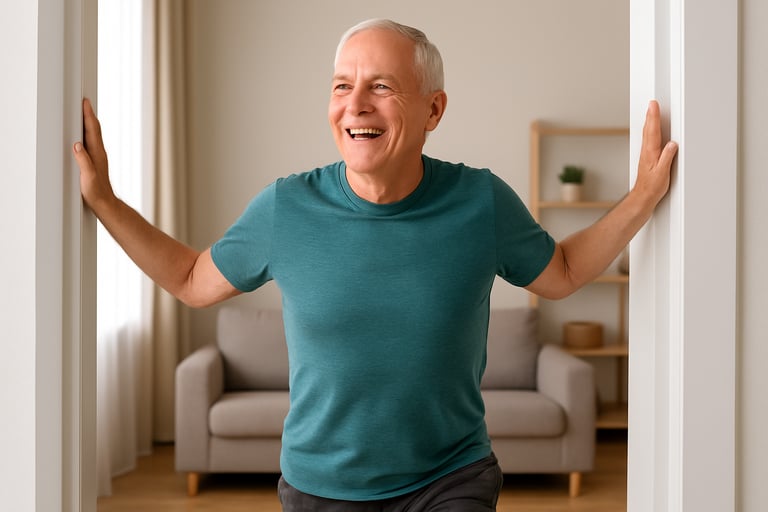Stand Tall Again: How Seniors Can Beat the Humpback Posture with Strength, Stretch, and a Dash of Humor
Discover why seniors develop hunchback posture (kyphosis) and learn safe, simple exercises and stretches to improve posture, balance, and confidence.
Bruce R Black
9/29/20253 min read


Stand Tall Again: How Seniors Can Beat the Humpback Posture with Strength, Stretch, and a Dash of Humor
Introduction
If you’ve ever looked in the mirror and thought, “Why do I look more like a question mark than an exclamation point?” — welcome to the club. Many older adults struggle with hunchback posture, also called kyphosis in seniors. It shows up as rounded shoulders, a forward head, and an upper back that curves more than we’d like.
The good news? While some causes of kyphosis are structural, much of it is due to weak and tight muscles. That means it can be improved with proper posture correction for seniors, including exercises that strengthen, stretch, and promote better daily habits.
In this post, we’ll unpack why older adults develop rounded shoulders and poor posture, the long-term consequences of ignoring it, and — most importantly — the best exercises to fix hunchback posture after 60.
Why Do Seniors Get Hunchback Posture?
1. Gravity and Modern Life
Gravity pulls us forward every day. Add in decades of desk work, smartphone scrolling, and TV watching, and it’s no wonder many of us develop rounded shoulders in older adults.
2. Muscle Imbalances
The chest muscles (pecs) get tight from everyday pushing and leaning, while the upper back muscles (traps, rhomboids, rotator cuff) get weak. Over time, the chest “wins” the tug-of-war, dragging your shoulders forward.
3. Age-Related Changes
As we age, spinal discs shrink and bone density decreases. That doesn’t doom us to kyphosis, but it does make posture habits more critical than ever.
4. Osteoporosis and Fractures
For some, osteoporosis can lead to minor vertebral fractures, which can cause an increase in spinal curvature. While kyphosis exercises can’t reverse fractures, they can prevent worsening by strengthening supportive muscles.
Consequences of Poor Posture in Seniors
It’s tempting to think, “So what if I round a little? I’m not modeling swimsuits.” However, poor posture is about more than just appearance.
Breathing Problems: A hunched upper back compresses the rib cage, making it harder to expand the lungs.
Neck and Back Pain: When your head shifts forward, the strain on neck and back muscles multiplies. Imagine holding a bowling ball out in front of you all day.
Balance Issues: Hunchback posture shifts your center of gravity, increasing fall risk.
Digestive Problems: A compressed torso can worsen heartburn or constipation.
Mood and Confidence: Standing tall feels energized; slouching feels “blah.” Body language directly affects mood.
So yes — improving posture isn’t just cosmetic. It’s about health, mobility, and independence.
The Best Posture Correction for Seniors
The uplifting news: posture problems are often muscle-related and habit-driven. Which means you can fight back.
1. Strengthen the Upper Back and Core
To correct hunchback posture in seniors, we need to strengthen the back and shoulder muscles.
Rows (with bands or light weights)
Sit tall, pull the band toward your ribs, and squeeze your shoulder blades like you’re pinching a pencil.Reverse Flys
With light weights or cans, hinge forward slightly and lift arms out to the side. Think “majestic eagle,” not “panicked hummingbird.”Wall Angels
Stand against a wall, arms in goalpost position. Slowly raise and lower them, keeping them as close to the wall as possible.
👉 And remember: our 10-minute workout for seniors covers posture, balance, and back-strengthening exercises for seniors all in one safe and simple routine.
2. Stretch the Chest and Neck
Tight chest muscles pull you forward. Stretching them helps unlock better posture.
Doorway Stretch
Arms at 90 degrees on a door frame, step through gently. Hold 30 seconds.Over-the-Bed Stretch
Lie on your back near the edge of the bed, letting your head hang slightly back. This gently stretches the front of your neck and chest.Foam Roller Stretch
Lie lengthwise on a foam roller, arms wide open. It’s like a mini spa day for your posture.
3. Build Daily Posture Habits
Strength and stretch are key, but habits seal the deal.
Reset every 30–60 minutes: Stand tall, roll your shoulders back, and breathe deeply.
Imagine a string lifting your chest — proud, not exaggerated.
Adjust your environment: raise your screen, sit in a supportive chair, hold your phone at eye level.
4. Don’t Forget the Core and Hips
Good posture relies on your whole body, not just your upper back. Strong abs, glutes, and hips stabilize the spine. Bridges, planks, and isometric holds help.
Yes — you guessed it — either our isometric exercises for seniors or the 10-minute workout for seniors, can be your posture solution.
A Daily Anti-Kyphosis Routine
Here’s a quick sequence you can do in 10–15 minutes daily:
Doorway Stretch — 30 seconds
Rows with Band — 10–15 reps
Wall Angels — 8–10 slow reps
Reverse Flys — 10–12 reps
Bridge or Plank — 20–30 seconds
Bed-Edge Stretch — 20–30 seconds
Consistency matters more than perfection. Do these regularly, and you’ll stand taller, breathe more easily, and move with greater confidence.
Closing Thoughts
Kyphosis in seniors may be common, but it’s not inevitable. With daily posture correction exercises for seniors, you can fight back against the hunchback posture. You’ll improve strength, flexibility, balance — and yes, even how tall and confident you look.
So here’s the challenge: every time you catch yourself slouching, straighten up and smile. You’re not just fixing posture — you’re reclaiming health, energy, and independence.
Stay strong, stay vibrant — age with ease.
Beat Age With Ease
Empowering seniors to achieve fitness and health.
© 2025. All rights reserved.
"Disclaimer: The fitness and exercise information provided on this website is intended for educational purposes only. It is not a substitute for professional medical advice, diagnosis, or treatment. Consult your physician or a qualified health provider before starting any exercise program. The use of any information provided on this site is solely at your own risk. We do not assume liability for any injuries or health issues that may result from using our content."
💛 Found something helpful? Sharing is free, but if you’d like to keep the lights on and the ideas flowing, you can buy me a coffee below.
